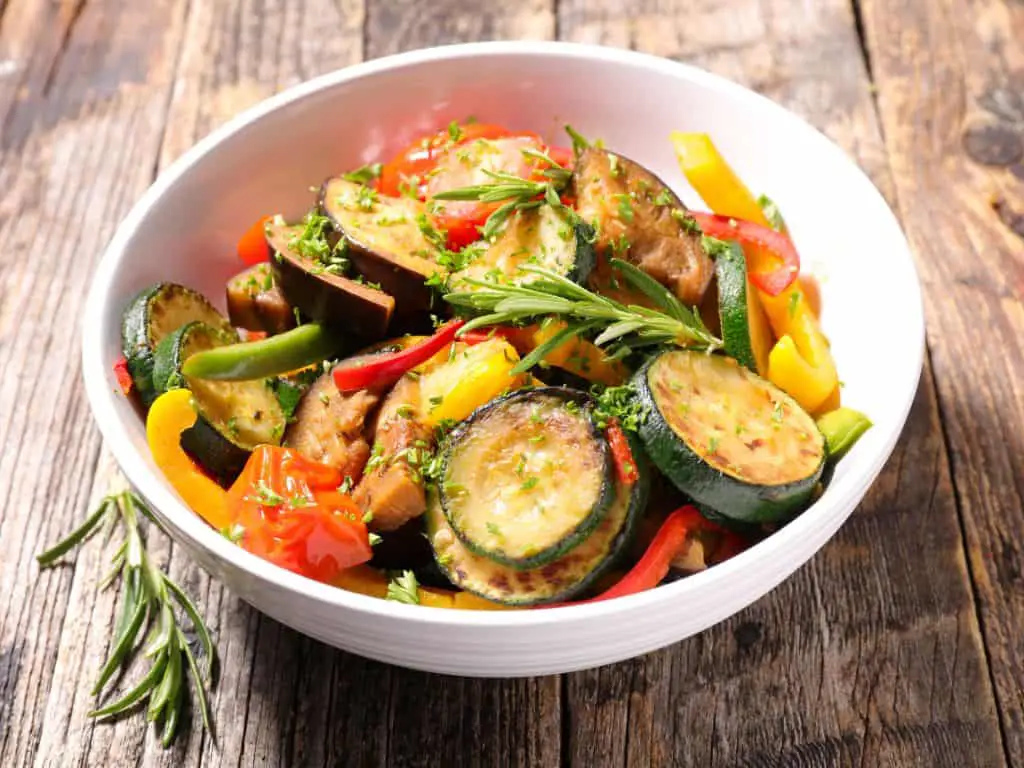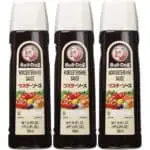Ratatouille is a classic French Provençal stew made with summer vegetables like tomatoes, zucchini, eggplant, bell peppers, and herbs. When perfectly cooked, the flavors meld together into a beautiful medley that captures the essence of the Mediterranean.
Ratatouille tastes like a savory, earthy medley of summer vegetables and herbs like tomatoes, zucchini, eggplant, bell peppers, onions, garlic, and basil. It is balanced with acidic sweetness from the tomatoes and flavored with herbaceous and floral notes, with texture contrasts that create satisfying mouthfeel. The flavors marry together during slow cooking to create a flavorful, rustic yet refined Mediterranean flavor.

So what exactly gives ratatouille its signature taste? Let’s break it down.
An Overview of Ratatouille
Ratatouille is a traditional dish from the Provence region of southern France. It likely originated as a peasant meal, utilizing fresh produce grown locally. While there are many variations, a classic ratatouille features the following ingredients:
- Tomatoes
- Zucchini
- Eggplant
- Bell peppers (usually green)
- Onions
- Garlic
- Herbs like basil, thyme, marjoram
- Olive oil
- Salt and pepper
The vegetables are sautéed separately at first to draw out moisture. Then they are combined and simmered together in an aromatic tomato sauce. This allows the flavors to meld into a savory, hearty stew.
Ratatouille can be served as a side or a vegetarian main. It also works well over pasta, polenta, or rice. The vegetables hold up well when reheated, making it a perfect summery make-ahead meal.
While ratatouille likely originated in Nice, it has become a hallmark of Provençal cuisine. It captures the herbs, olive oil, tomatoes, and laid-back style that the region is known for.
The Well-Balanced, Satisfying Flavor Profile
So what makes ratatouille taste so good? It comes down to a perfect balance of flavors and textures:
Savory and Earthy Depth
The combination of vegetables, herbs, olive oil, and slow cooking creates complex, savory depth. As the tomatoes break down, they form a rich sauce infused with the earthy flavors of the vegetables.
Eggplant is key for adding meatiness along with its mild bitterness. Onions and garlic provide umami savoriness. Zucchini lends freshness while absorbing other flavors.
Sweetness and Acidity
The tomatoes offer sweet flavor and acidic brightness to balance out the other vegetables. Basil adds a hint of anise-like sweetness as well.
Herbaceous and Floral Notes
Herbaceous flavor notes come from basil, thyme, marjoram, and other herbs. These provide floral, slightly peppery nuances without overpowering.
Texture Contrasts
The ratatouille has an appealing mix of textures. The eggplant and zucchini are firm yet yielding. The peppers add crunch while the tomatoes create a luscious sauce. This creates satisfying mouthfeel.
Savory Yet Fresh
Despite the long cooking, the vegetables retain a pleasant freshness. This keeps the stew from feeling too heavy or mushy. The flavors marry without losing each ingredient’s identity.
So in short, ratatouille gains its signature flavor from:
- Sweet, acidic tomatoes
- Earthy, meaty eggplant
- Savory aromatics like garlic and onion
- A blend of fresh herbs
- Bright vegetables
- The way the flavors mingle during slow cooking
When done right, these elements create a flavorful, herbaceous, rustic yet refined Mediterranean flavor. The stew is deeply satisfying but feels light enough for summer.
Regional Variations Showcase Local Ingredients
There are many regional forms of ratatouille beyond the Provençal classic. These highlight local produce and specialty ingredients:
Niçoise Ratatouille
Niçoise ratatouille comes from Nice on the French Riviera. It features green beans and often adds pistou, a pesto-like sauce, for more herbal flavor.
Tian
A tian is ratatouille baked in a shallow earthenware dish. It can include breadcrumbs or grated cheese on top for texture.
Pisto
Pisto is a Spanish take, made with onions, peppers, zucchini, and sometimes potatoes. It has a thicker, more stew-like texture.
Shakshuka
Shakshuka is an Israeli/North African dish of eggs poached in a spicy tomato-bell pepper sauce similar to ratatouille. It adds heat from chilies and cumin.
Caponata
Caponata is a Sicilian eggplant stew with capers, olives, celery, and sweet-sour notes from vinegar and raisins. It makes a flavorful topping for crostini.
Giambotta
Giambotta is an Italian vegetable stew with broth that makes it almost soup-like. It often includes potatoes, beans, and greens like cabbage or chard.
As you can see, the basic flavors of ratatouille lend themselves well to interpretation based on regional cuisines. The vegetables may change with the season or location, but the stew remains highly adaptable while keeping its essential character.
Key Factors for Getting the Best Flavor
Ratatouille’s flavor relies heavily on careful prep and technique:
- High quality olive oil – Use a good French or Italian extra virgin olive oil. The flavor really shines through.
- Fresh, peak season vegetables – Choose produce in summer/early fall for sweetness and structural integrity.
- Salting eggplant – Salt sliced eggplant ahead to remove bitterness and excess moisture.
- Sautéing in batches – Each vegetable is sautéed separately at first to maximize browning.
- Layering – Vegetables are added in stages, building flavor layer by layer.
- Simmering – The stew then simmers 20-40 minutes to blend flavors and break down tomatoes.
- Herb infusion – Add torn herbs towards the end to preserve their vibrancy.
- Seasoning – Taste and adjust salt, pepper, and herbs before serving.
Getting the textures and cooking times right is also key. Each vegetable should be just tender but not mushy. Follow an authentic recipe and you’re guaranteed an amazing flavor experience.
Serving Up Delicious Ratatouille
Ratatouille is extremely versatile beyond just a side dish. Some tasty ways to enjoy it:
- Scooped over crusty bread as a bruschetta
- Served over rice, couscous, or polenta
- Tossed with pasta or gnocchi
- Topped with a fried egg or poached egg
- Dolloped on toasted baguette as an appetizer
- Used as a sauce under chicken, fish, or lamb
- Added to pizza or flatbreads
- Whizzed into a soup with chicken stock
- Puréed with olive oil for a vegetable dip
- Baked into savory tarts or galettes
The possibilities are endless! Ratatouille also stores well for 4-5 days refrigerated or 2-3 months frozen. It’s an ideal make-ahead meal for busy schedules.
Ratatouille Truly Captures the Essence of Mediterranean Flavors
With its blend of textures, colors, and aromas, ratatouille encapsulates the warmth and vibrancy of the Mediterranean. When you take a bite, the savory, herbaceous flavors transport you right to a sunny day in Provence.
Yet it remains humble and approachable. Like the best comfort foods, ratatouille nourishes you with simple ingredients united through caring hands.
So next time you see peak season eggplant and tomatoes at the market, consider making ratatouille. Let the flavorful, earthy stew fill your kitchen with the scents of summer in southern France. Just one bite tells you everything you need to know about why ratatouille has remained a classic for centuries.
































